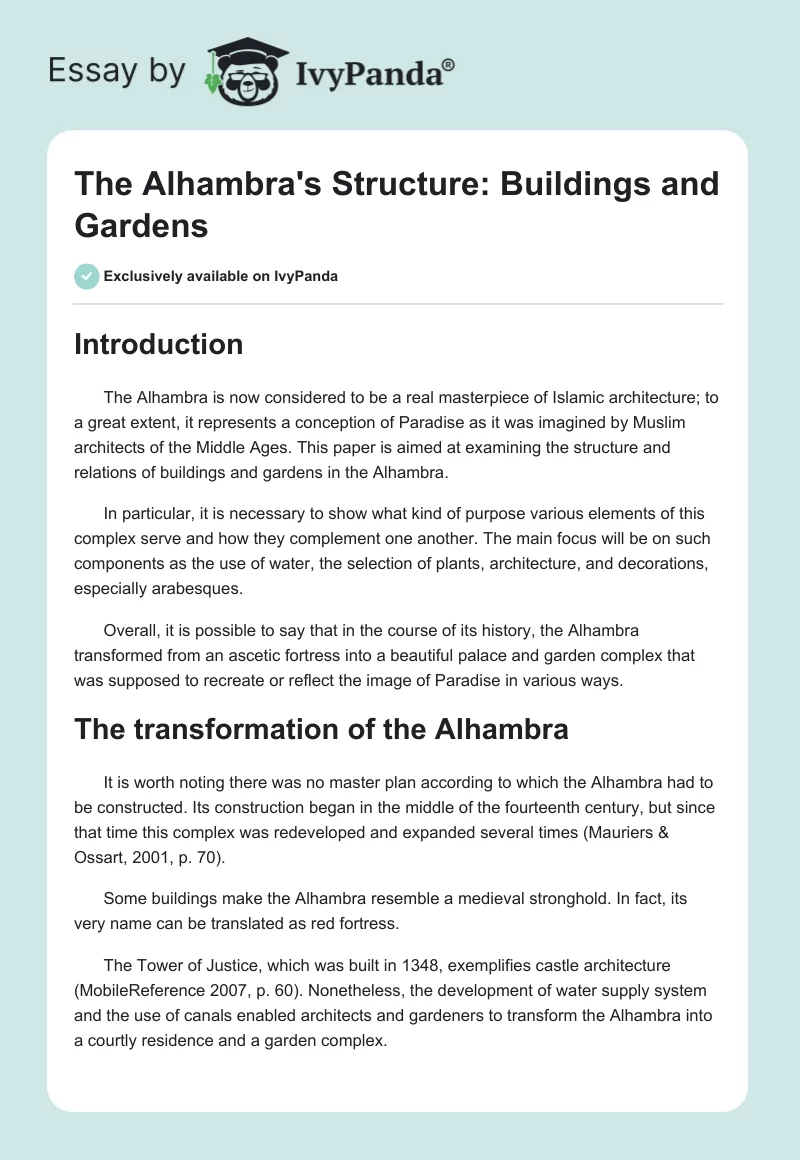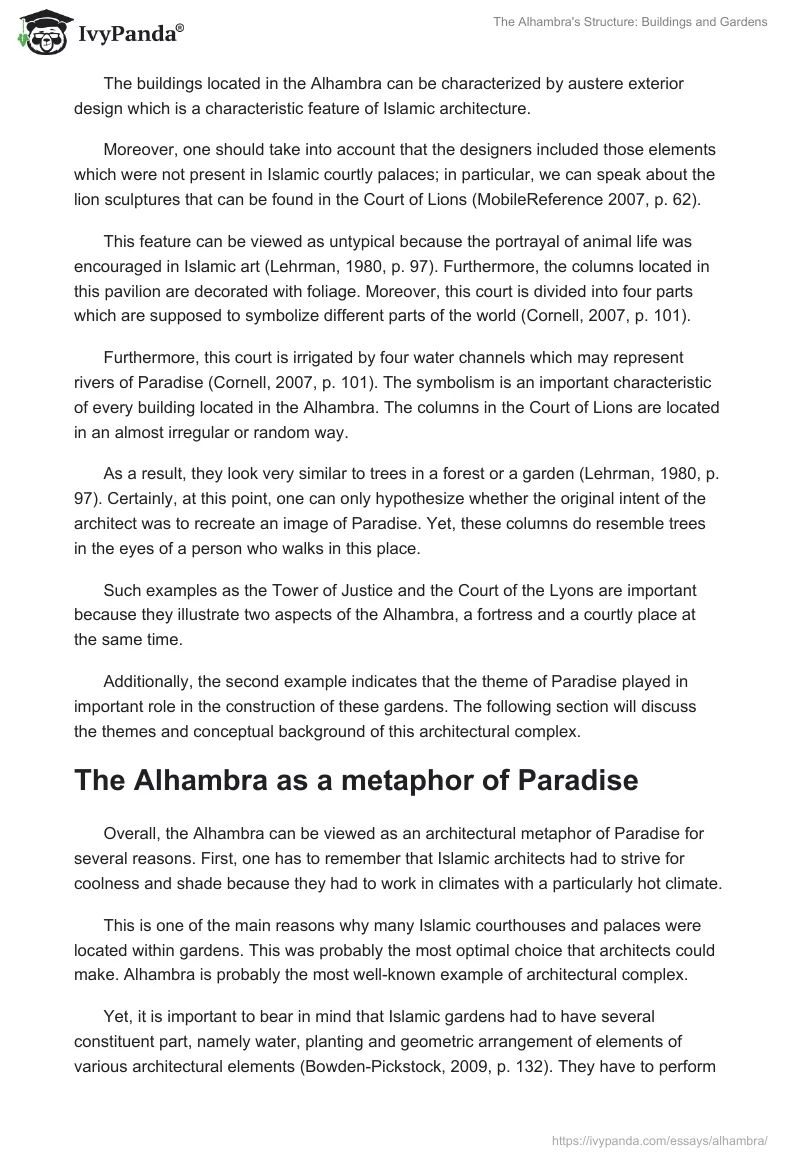Introduction
The Alhambra is now considered to be a real masterpiece of Islamic architecture; to a great extent, it represents a conception of Paradise as it was imagined by Muslim architects of the Middle Ages. This paper is aimed at examining the structure and relations of buildings and gardens in the Alhambra.
In particular, it is necessary to show what kind of purpose various elements of this complex serve and how they complement one another. The main focus will be on such components as the use of water, the selection of plants, architecture, and decorations, especially arabesques.
Overall, it is possible to say that in the course of its history, the Alhambra transformed from an ascetic fortress into a beautiful palace and garden complex that was supposed to recreate or reflect the image of Paradise in various ways.
The transformation of the Alhambra
It is worth noting there was no master plan according to which the Alhambra had to be constructed. Its construction began in the middle of the fourteenth century, but since that time this complex was redeveloped and expanded several times (Mauriers & Ossart, 2001, p. 70).
Some buildings make the Alhambra resemble a medieval stronghold. In fact, its very name can be translated as red fortress.
The Tower of Justice, which was built in 1348, exemplifies castle architecture (MobileReference 2007, p. 60). Nonetheless, the development of water supply system and the use of canals enabled architects and gardeners to transform the Alhambra into a courtly residence and a garden complex.
The buildings located in the Alhambra can be characterized by austere exterior design which is a characteristic feature of Islamic architecture.
Moreover, one should take into account that the designers included those elements which were not present in Islamic courtly palaces; in particular, we can speak about the lion sculptures that can be found in the Court of Lions (MobileReference 2007, p. 62).
This feature can be viewed as untypical because the portrayal of animal life was encouraged in Islamic art (Lehrman, 1980, p. 97). Furthermore, the columns located in this pavilion are decorated with foliage. Moreover, this court is divided into four parts which are supposed to symbolize different parts of the world (Cornell, 2007, p. 101).
Furthermore, this court is irrigated by four water channels which may represent rivers of Paradise (Cornell, 2007, p. 101). The symbolism is an important characteristic of every building located in the Alhambra. The columns in the Court of Lions are located in an almost irregular or random way.
As a result, they look very similar to trees in a forest or a garden (Lehrman, 1980, p. 97). Certainly, at this point, one can only hypothesize whether the original intent of the architect was to recreate an image of Paradise. Yet, these columns do resemble trees in the eyes of a person who walks in this place.
Such examples as the Tower of Justice and the Court of the Lyons are important because they illustrate two aspects of the Alhambra, a fortress and a courtly place at the same time.
Additionally, the second example indicates that the theme of Paradise played in important role in the construction of these gardens. The following section will discuss the themes and conceptual background of this architectural complex.
The Alhambra as a metaphor of Paradise
Overall, the Alhambra can be viewed as an architectural metaphor of Paradise for several reasons. First, one has to remember that Islamic architects had to strive for coolness and shade because they had to work in climates with a particularly hot climate.
This is one of the main reasons why many Islamic courthouses and palaces were located within gardens. This was probably the most optimal choice that architects could make. Alhambra is probably the most well-known example of architectural complex.
Yet, it is important to bear in mind that Islamic gardens had to have several constituent part, namely water, planting and geometric arrangement of elements of various architectural elements (Bowden-Pickstock, 2009, p. 132). They have to perform several functions, apart from bringing shade and coolness. First, they have to be pleasing to the eye, but they also have to remind visitors about harmony and peace of mind.
As a rule, such architectural places are often called paradise gardens because they reflected the description of Paradise provided in Quran. This concept originated from Ancient Persia, but it later became very popular in Islamic architecture. On the whole, the Alhambra eloquently illustrates the notion of a paradise garden.
First, the gardens of the Alhambra are surrounded by a fortified wall; to some degree. This layout is reminiscent to the notion of enclosed paradise garden that is not accessible to everyone (Bowden-Pickstock, 2009, p 130). Various entrance gates to this garden can symbolize the gates to Paradise that are open only to righteous people.
As it has been pointed out before, the presence of such gates can be explained by the fact that for a long time, the Alhambra was used as a stronghold. Additionally, one has to speak about the importance of fountains in this place. The thing is that according to Muslim views, Paradise is a reminiscent of a garden in which large trees grow and water springs never become depleted.
This problem was of great importance to Moors who lived in the medieval Spain. This is one of the reasons why there are so many fountains in the Alhambra. In this regard, one can definitely mention the fountain near the palace called Generalife (Mauriers & Ossart, 2001, p. 70).
The cascading water was to symbolize the splendor of Paradise. Additionally, it had to act as music for visitors. These fountains also show that the construction of this site required a significant amount of engineering effort.
Apart from that, there are many pools in Alhambra and they reflect the facades of buildings. In many cases, such reflections appear to be more even more fascinating than the buildings themselves. This type of visual effects demonstrates the excellent of those architects who created these gardens.
This is an example of how different elements of the Alhambra can interact with one another. Water does not serve only practical purposes such as cooling or refreshment.
As it has been said before, fountains, pools and channels have to represent rivers of Paradise. They can also produce a very calming impression on the view. This is also an important function because the paradise garden must be a place of peace and tranquility.
The second important aspect which should be discussed is the role of plants. In Islamic architecture, gardens can be divided into two categories: 1) bustan gardens which were used for agricultural purposes mostly, and 2) gulistan gardens that served mostly aesthetic purposes and had to be pleasing to the eye (Bowden-Pickstock, 2009, p 130).
The Alhambra gardens represent both these types. The thing is that there are many fig, olive and cedar trees in this place and their fruits fed many people who lived inside or outside the Alhambra (Bowden-Pickstock, 2009, p 130). Yet, these gardens are also fool of ornamental flowers which are planted their mostly for aesthetic reasons.
Again, they create a structure and aesthetic union with buildings and fountains of the Alhambra. The choice of plants is also related to the concept of paradise. First of all, fig and olive trees are important for Islamic faith because they are mentioned in Quran (Bowden-Pickstock, 2009, p 135).
Thus a paradise garden has to provide plenty of food to its dwellers and be pleasing to the eye of an onlooker at the same time. Therefore, one can argue the Alhambra was an attempt to recreate such a garden.
Furthermore, this discussion should touch upon the importance of architecture and the use of geometry in the Alhambra. In the previous session, we have already mentioned that the Court of the Lyons was divided into four sections that were supposed to symbolize four parts of the world (Cornell, 2007, p. 101).
Yet, this is only detail exemplifying the use of geometric forms. The interior and exterior sides of building located in the Alhambra are full of arabesques, rectangular figures or other decorative elements resembled flowers. In part, the entangled lines of arabesques symbolize growing plants and flowers in the garden.
Secondly, the location of palaces is also important. The thing is that from outside palaces are virtually drowned by gardens. This impression is particularly strong when a person looks at the Alhambra from outside. Furthermore, there are no places within the Alhambra that do not have trees or flowers.
Overall, this discussion shows that different elements of the Alhambra are supposed to conjure up the image of garden in which a person can be distracted from earthly problems. The selection of plants, fountains, the location of buildings, and various decorative elements such as arabesque were designed to recreate the image of the paradise garden. The metaphor of the garden is conveyed in several ways.
First, one can speak about the emphasis on fountains and plants which can reflect the atmosphere of the paradise garden. Yet, one should not disregard the importance of architectural and decorative elements such as arabesques and columns symbolize flowers or trees.
Overall, the theme of paradise is crucial for this architectural complex, and each element strives to emphasize the idea that this place is an attempt to recreate Paradise.
Conclusion
In the course of its history, Alhambra was redeveloped several times, but this architectural site retained its image of the paradise garden. Various elements of this complex symbolize the paradise garden, a concept which is very widespread in Islamic architecture.
This complex evolved from a fortress into one of the most beautiful courtly places in Spain. Certainly, it is not the first architectural complex that is based on the idea of the paradise garden, but it is definitely one of the most famous ones.
References
Bowden-Pickstock, S 2009, Quiet Gardens: The Roots of Faith?, Continuum International Publishing Group, New York.
Cornell, V 2007, Voices of Islam: Voices of art, beauty, and science, Greenwood Publishing Group, New York.
Lehrman, J 1980. Earthly Paradise: Garden and Courtyard in Islam, University of California Press, LA: Berkeley.
Mauriers, A & Ossart, E. 2001, Paradise Gardens, I.B.Tauris, London.
MobileReference. 2007. Travel Andalusia, Spain for Smartphones and Mobile Devices – Illustrated Travel Guide, Maps, and Phrasebook, MobileReference, New York.


